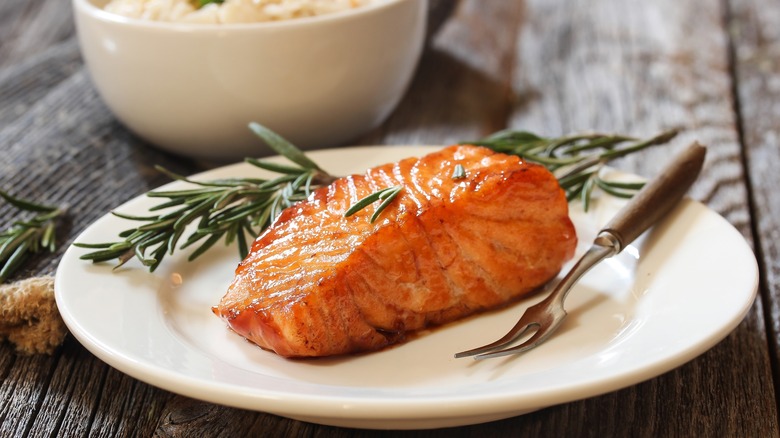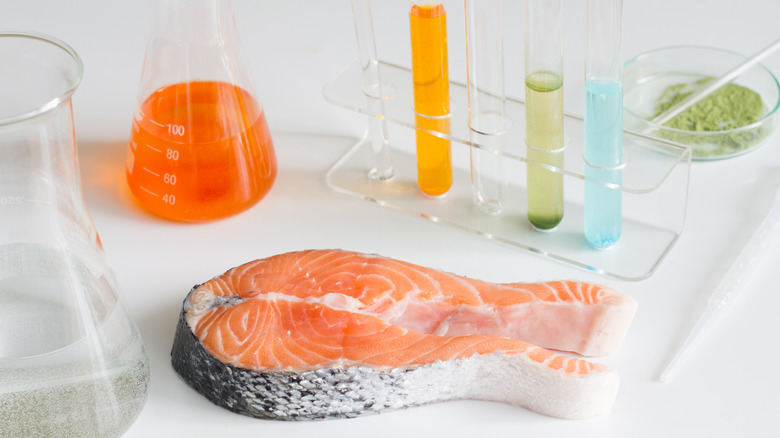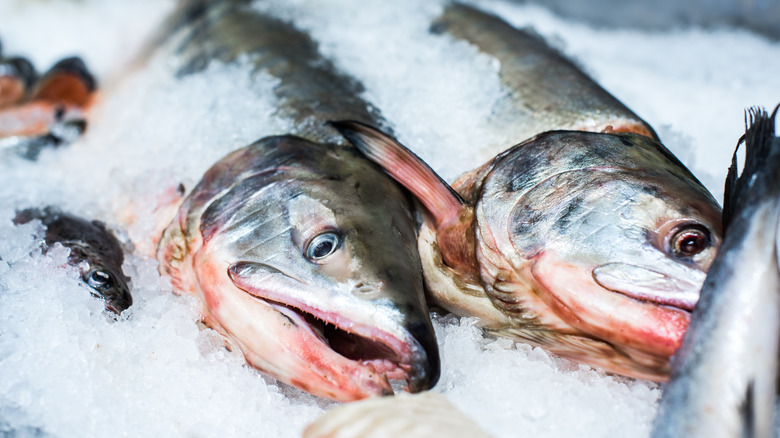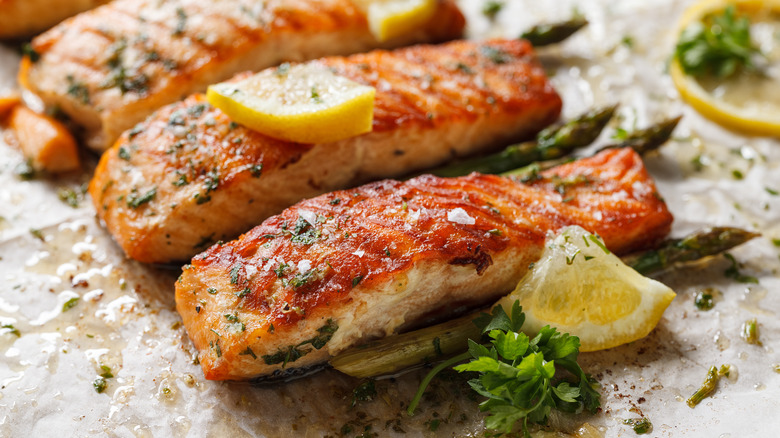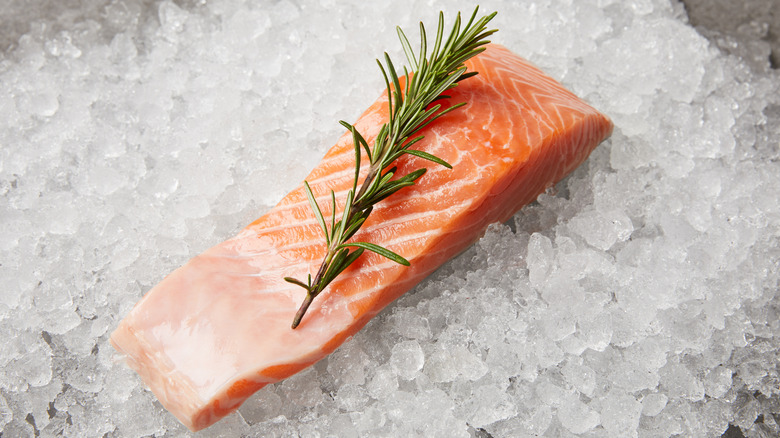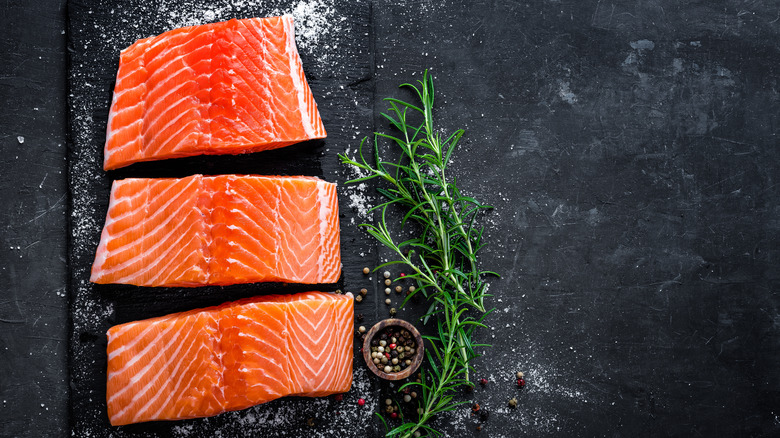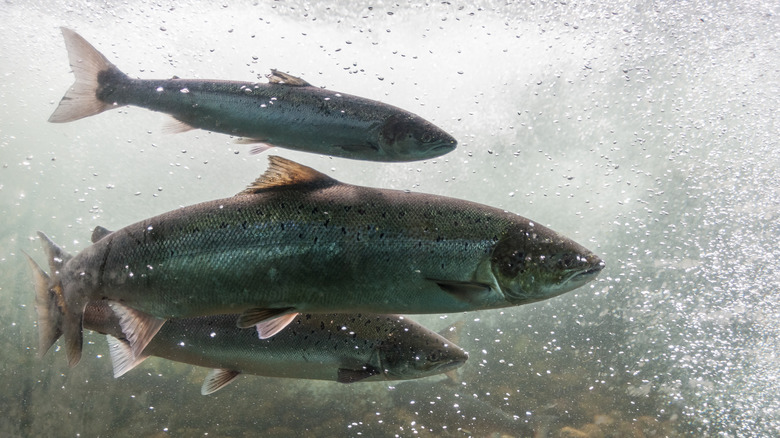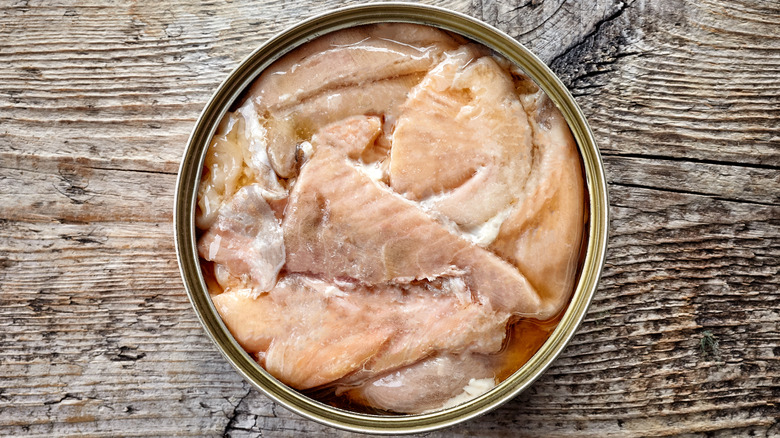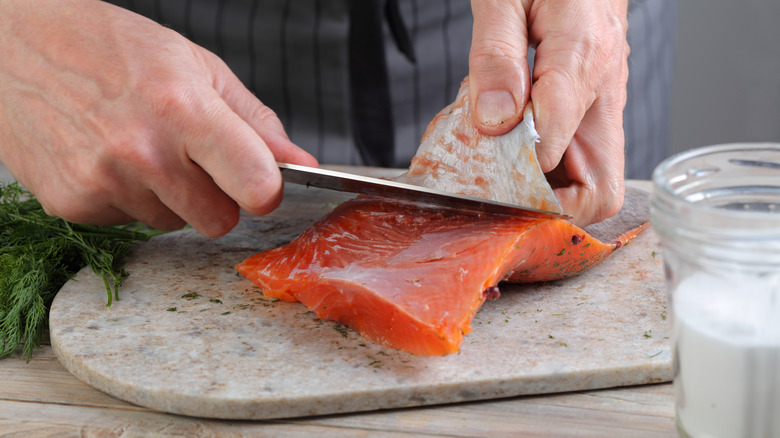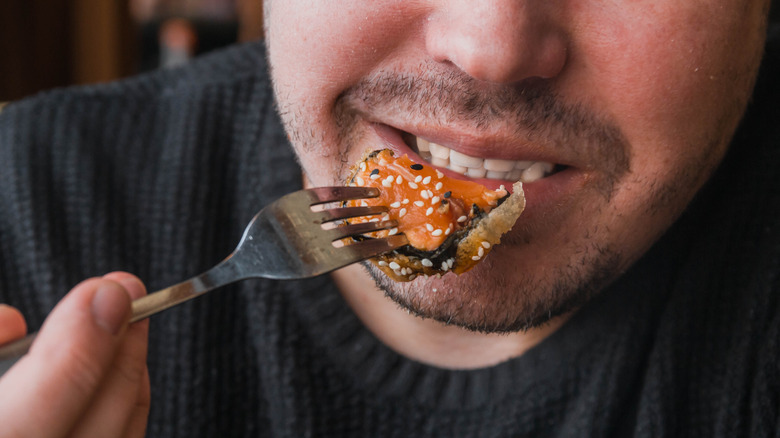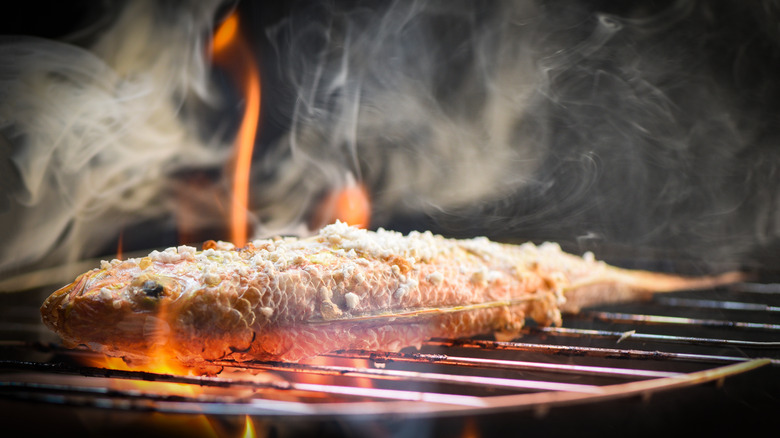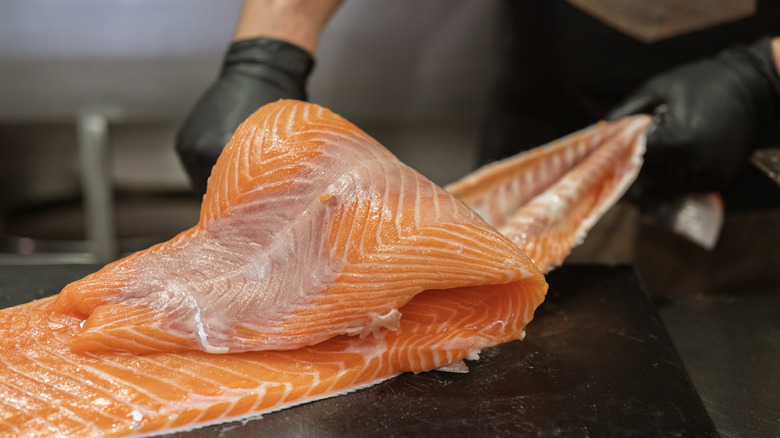False Facts About Salmon You Thought Were True
Salmon are renowned for their leaping prowess, savory taste, and striking red hues. Yet, myths and misconceptions have shrouded these remarkable fish and their delightful flavors. Many prevalent beliefs about salmon are more fictional than factual, particularly concerning the subtle nuances of their taste and texture, significantly influenced by their diverse environments.
Some argue that wild salmon are inherently superior, overlooking the distinct qualities of their hatchery-bred or farmed counterparts. Others mistakenly assume salmon's natural hue is always pink, and some even believe they live exclusively in the sea — ignoring their incredible freshwater journeys to spawn in their birth streams and exceptional tolerance for both salt and freshwater.
Debates in culinary circles also persist about cooking methods, health benefits, and ideal food pairings with salmon. However, these opinions often stem from exaggeration or generalization. To truly understand salmon, we must move past these alleged myths and focus on the juicy facts. There's much to uncover and numerous salmon myths to debunk, so read on. You might be surprised by what you discover about this extraordinary fish to challenge your widely held misconceptions.
False: All salmon species are high in mercury
The myth that all salmon species are high in mercury stems from broader concerns about mercury in various types of seafood. Levels vary significantly based on the animal's size, age, and diet. Larger predatory fish like swordfish and sharks accumulate more mercury due to their longer lifespans and fish-based diets, contrasting sharply with salmon.
Wild salmon, such as Sockeye and King, boast much lower mercury levels thanks to their shorter lifespans and dietary habits. Wild, farmed, and canned salmon are similarly low in mercury, with levels ranging from about 0.01 to 0.02 parts per million, per the U.S. Food & Drug Administration (FDA). These levels are considered a safe choice to consume up to three times a week, including among people with sensitive dietary requirements, such as during pregnancy, breastfeeding, and in youth.
The generalization of high mercury levels in all types of salmon is misleading. Wild-caught and farmed salmon remain healthy, delicious choices far removed from the high mercury concerns associated with larger predatory fish, giving them the "best choice" seal of approval by the FDA.
False: Farmed salmon is just as nutritious as wild salmon
Misunderstandings about salmon's diets and living conditions are the genesis of this widespread myth. Farmed salmon are not nutritionally equivalent to wild salmon. Both are salmon species, but their habitats drastically alter their nutritional profiles.
Wild salmon thrive in natural waters, consuming a diet rich in tiny crustaceans, shrimp, and krill. Such a diet grants them a superior omega-3 to omega-6 fatty acid ratio, higher levels of natural minerals such as iron and calcium, and a lower saturated fat content. Conversely, farmed salmon are reared on a processed fish feed diet lacking natural variety. Although this diet maintains basic nutritional needs, it alters their nutrient balance. Farmed salmon typically contain more fat, including saturated fat, and have a less favorable omega-3 to omega-6 fatty ratio than their wild counterparts.
Another notable difference between the two is their color. Wild salmon's distinct reddish-orange pigment comes from astaxanthin, a compound naturally present in their diet. Farmed salmon, deprived of it in their feed, are often given synthetic astaxanthin to replicate the characteristic pink hue. This distinction is a visual cue to the more profound nutritional disparities between wild and farmed salmon, emphasizing the importance of making informed dietary choices.
False: Salmon must be cooked through completely
Ever been told salmon needs to cook through and through, like a well-done steak? We've all knowingly overcooked salmon at some point, convinced it was the only way to avoid foodborne illnesses. After all, complete cooking eliminates harmful bacteria and parasites. While this approach is generally true for most meats and fish, it's not a one-size-fits-all rule, particularly when it comes to high-grade salmon.
High-quality salmon, celebrated for its freshness and proper handling, can be safely enjoyed even when cooked to medium or medium-rare. Aim for around 125 F for farmed salmon and 120 F for wild salmon. This doneness level preserves the salmon's moisture and flavor, which are often lost in overcooking. Fresh, adequately sourced, or correctly frozen high-quality salmon reduces the risk of harmful pathogens, a concern with undercooked fish. It's a common practice in reputable restaurants to serve medium rare salmon, and this practice aligns with culinary preference and food safety standards.
Cooking fish at an optimal temperature of 145 F and measuring it with a trusty food thermometer is recommended by the U.S. Department of Agriculture. However, for well-sourced salmon, chefs and food safety experts suggest a slightly lower temperature, ensuring the fish is cooked enough to lose its translucency. This method enhances the dining experience, delighting food enthusiasts and health-conscious diners alike.
False: Fresh salmon is always better than frozen
Another fishy myth swimming around is that fresh salmon is always superior to its frozen counterparts. This common belief is often rooted in misconceptions about freshness and the freezing process. The prevailing thought is that "fresh" translates to "just caught," suggesting that salmon sporting this label is the pinnacle of flavor and nutritional value. This pervasive notion relies on the idea that the quality of fish drastically diminishes the longer it stays out of water.
However, this belief doesn't hold up against the benefits of flash-freezing. This technology uses extremely low temperatures to quickly freeze the fish, preventing ice crystals from forming and damaging the protein cells. Flash-freezing salmon, done almost immediately after it's caught, halts bacteria growth, preserves nutrients, and locks in rich flavor, keeping the salmon's quality at its peak freshness.
In contrast, the "fresh" salmon in grocery aisles (often less fresh than you'd expect), has undergone a long journey while enduring multiple temperature changes, slowly degrading its texture, flavor, and nutritional value — making it less ideal for a baked salmon dinner. So, don't dismiss frozen salmon as a lower-quality option. Thanks to flash-freezing, it often maintains the same, if not better, quality as its fresh counterparts. Frozen salmon is a shining example of modern preservation methods and consistently offers a premium seafood experience.
False: The pinker the salmon, the better
You've seen them on grocery shelves — salmon fillets boasting a glistening, distinct pink hue. This vivid color draws us in, misleading us into believing the fish is high quality. This belief stems from associating bright colors with freshness and health benefits. Wild salmon acquire their pink color from astaxanthin, a compound in their natural crustaceans and algae diet. A richer natural diet often leads to a deeper pink, further reinforcing the link between color and quality.
Even so, salmon's bright color is not a reliable quality indicator. According to the Center for Food Safety, about 95% of the salmon in standard grocery stores are farmed, and most are fed dyes to mimic wild salmon and make them more appealing to consumers. So, salmon's pinkness doesn't necessarily reflect quality or an abundant natural diet. Instead, pay attention to other factors influencing quality, such as origin (whether wild or farmed), farming practices, and freshness.
Although wild salmon have several inherent advantages, sustainable practices can yield high-quality farmed salmon. Freshness is also crucial — look for salmon with firm flesh, clear eyes, and a mild scent. While a vibrant pink hue may catch your eye, it doesn't tell the whole story. Investigate the source and handling of the salmon before you buy it.
False: Wild salmon is always sustainable
We identify salmon as a popular, delicious seafood, but is it eco-friendly? Many believe wild salmon is a sustainable choice, considering the fish are free-swimming and the process is less harmful than aquaculture. But this is only partially true. The sustainability of wild salmon heavily depends on the species and fishing practices.
Some species, like farmed Atlantic salmon, are well-managed and sustainable, but others like Chinook salmon are seriously threatened by overfishing. The fishing methods matter, and unfortunately, not all practices have a sustainable environmental impact. For example, gillnetting can accidentally catch and kill other marine life, whereas trolling is more selective and less harmful.
So, how do we know which wild salmon varieties are sustainably managed and healthy? Look for certifications like the Marine Stewardship Council (MSC) label, indicating sustainable fishing sources. The MSC label details healthy fish populations, eco-friendly fishing practices, and whether a fishery is well-managed. Ultimately, the assertion that all types of wild salmon are sustainable is misleading. Opt for MSC-certified wild salmon to savor its taste and health benefits while supporting ocean conservation and biodiversity.
False: Canned salmon is less nutritious
The myth that canned salmon is less nutritious than its fancy fresh cousin originates from misconceptions about processed foods. While it's true that processing affects texture and flavor, it doesn't significantly diminish salmon's nutritional value. Contrary to popular belief, canned salmon is a nutritional powerhouse in its own right, often packing a treasure trove of essential nutrients, including vitamins D and B12, omega-3 fatty acids, and protein, with zero carbs. Plus, you get a bonus — calcium and selenium from the canned soft bones, often discarded when cooking fresh salmon.
Canned salmon is a nutritious alternative to fresh salmon, and let's not forget the convenience and affordability factor. It's shelf-stable and a practical choice for quick meals, making it ideal for busy, budget-conscious eaters with limited access to fresh seafood. Contrary to belief, the canning process doesn't degrade salmon's nutrients. Instead, it locks them in, making it a reliable, rich source of essential nutrients — dispelling the myth that canned salmon is a nutritionally inferior option.
If anything, canned salmon is a versatile, nutrient-packed food option that ensures you can enjoy the fish's health benefits wherever you are. The next time you reach for a can of salmon, embrace it as a viable, nutritious option; you're not just getting a delicious meal but a nutritional MVP disguised in a tin suit.
False: Salmon skin should always be removed before cooking
Admit it; you often toss the rubbery salmon skin aside like old bait, convinced it's just a slimy afterthought. But it's not necessary to strip salmon of its skin before cooking. This myth likely stems from concerns about contaminants, a preference for the texture of skinless fish, or misconceptions that the salmon's silvery skin layer affects the flavor — often a result of undercooked or improperly prepared skin.
Salmon skin packs a hefty nutritional punch, chock-full of heart-healthy omega-3 fatty acids, vitamin D, and minerals like phosphorous and niacin. When crisped up correctly, the skin transforms into a delightful texture, crackling like potato chips and adding a salty richness that enhances the overall dish. It also subtly protects the delicate salmon flesh from drying out, ensuring a flakier, juicier bite.
Salmon skin is safe and healthy when prepared correctly, adding a whole new dimension to the delicious dish. The key lies in sourcing good quality salmon and cooking it with high heat to crisp the skin. So, next time you cook salmon, try leaving the skin on. And for the skeptics, remember that crispy salmon skin chips are, in fact, a gourmet delicacy.
False: All salmon tastes the same
So you think all salmon tastes the same? Think again. It's easy to fall into this generalization trap, especially when grocery aisles offer a uniform pink landscape of salmon. Still, this oversimplification overlooks the rich diversity among salmon species and the profound impact of their unique diets and habitats on flavor.
Consider the King salmon, also known as Chinook, with its high-fat content and buttery, melt-in-your-mouth texture. Sockeye salmon, in contrast, rocks a vibrant orange hue and a bold, almost briny taste after feasting on plankton, krill, and shrimp. Habitat matters, too. Wild salmon — traversing vast oceans, icy rivers, and even hanging out in landlocked lakes — consume a natural diet, leading to a complex and varied flavor profile. This contrasts starkly with farmed salmon, which feed on a controlled diet, resulting in a milder, more consistent taste.
The water's temperature and quality also influence the taste. Salmon from colder waters typically have a higher omega-3 fat content, contributing to a firmer texture and robust flavor. Warmer climates create softer, fattier fish. This flavor diversity reflects the ecological variety of salmon species and their habitats. From Alaska's icy waters to Norway's clear streams, each region imparts a unique signature to the salmon's flavor. As you enjoy your dish, remember that you're not just tasting fish; you're savoring a symphony of flavors shaped by nature.
False: Smoked salmon is cooked
Smoked salmon is often mistaken as being cooked due to the common association between cooking and heat. This misconception arises from cooking's transformative effect on food's texture, flavor, and appearance. However, smoked salmon blurs these conventional boundaries.
Traditional smoked salmon is made by curing and smoking, not cooking. The process starts with curing, where salmon is coated with salt, sugar, and sometimes a blend of spices. This process draws out moisture, inhibits bacteria growth, and prolongs shelf life while adding flavor. Smoking then exposes the salmon to low-temperature smoke, ranging between 70 F and 85 F, imparting a distinct smoky flavor and unique texture without cooking it in the traditional sense.
Unlike typical cooking which alters food's internal structure, making it safer or easier to digest, low-temperature smoking doesn't induce such changes. The salmon stays close to its raw state, distinct from cooked salmon. This process gives smoked salmon a unique culinary status, known for its delicate texture and rich smoky taste that sets it apart from cooked varieties.
False: The gray area under salmon skin should always be removed
We can all agree that the gray-brown area (aka "fat line") beneath the salmon skin looks a bit gross and easily triggers an "ew" response in some. Plus, it harbors tiny, white pin bones, making it seemingly unsavory. Contrasting the salmon's vibrant pink hue, common wisdom wrongly suggests its removal.
This unfounded advice often overlooks the layer's nutritional and culinary value. The gray area is actually a goldmine for omega-3 fatty acids and contains a greater proportion than the rest of the protein, due to its fatty composition. These fats offer many benefits, including improved heart health, decreased inflammation, and protective properties against cancer and other diseases.
When cooking, especially grilling or pan-searing, this layer partly dissolves, basting the salmon to enhance moisture and richness. This fatty layer simply counters the drier texture of skinless, fat-trimmed salmon. Chefs also value the grayish layer for its ability to make the fish succulent and flavorful. So, leave it on for juicier salmon with beneficial fats that elevate its flavor. Your taste buds will thank you.
